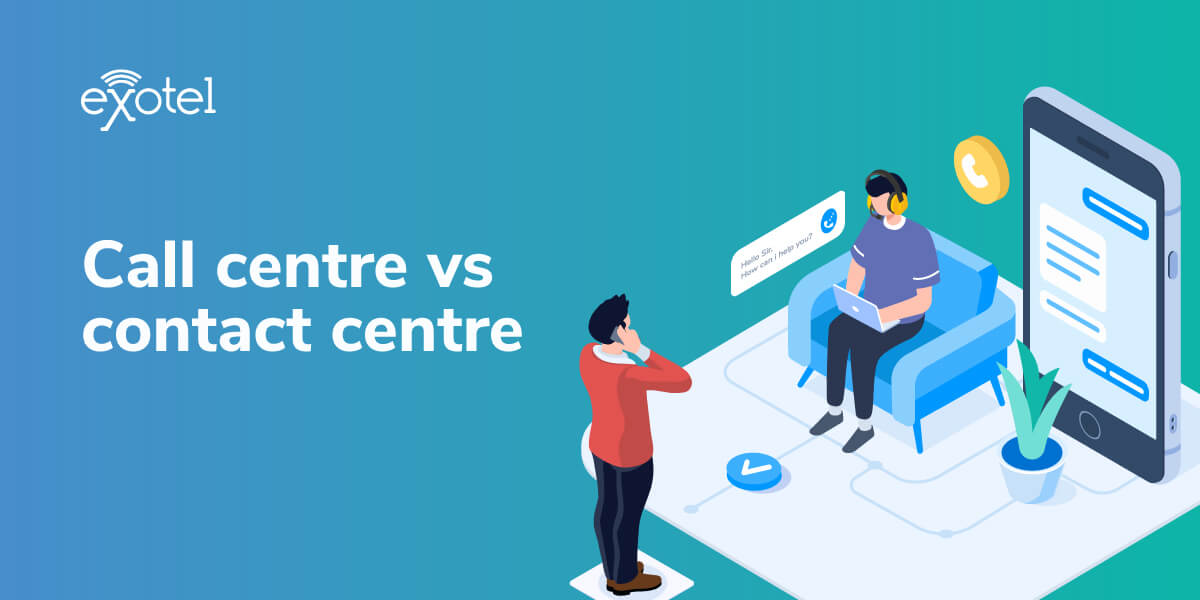Call centers and contact centers both exist for the same purpose – to resolve customer queries and provide customers with a reliable way of reaching a company. But the channels that they use to achieve this are different. However, modern call centers now have features that are bridging the gap between call centers and contact centers. In this blog, we’ll talk about capabilities that modern call centers have that ensure that your employees and customers have the same experience as that of a contact center.
What is a Contact Center?
A contact center allows agents to communicate with customers across different channels like voice calls, email, SMS, live chat, and video conferencing. This unifies all the channels and allows for better and more contextual communication to be delivered to the customer. Since most of these channels can only be accessed over the internet, contact centers offer flexibility and are available as cloud contact center solution.
What is a Call Center?
A call center allows agents to handle incoming and outgoing customer communication at scale. All of this communication happens over a single channel — voice calls. Traditionally, these calls were routed only via on-prem phone systems out of a single office and afforded no flexibility. But call centers have evolved since and now come with features that are comparable to a contact center.
Call centers’ move to the cloud has opened up a host of opportunities and has taken away most of the pain points associated with using a traditional call center. Using a cloud call center, businesses can easily enable their employees to work remotely. They can also make changes to the IVR call flow instantly, without requiring the help of a technician. Modern call centers come with extensive reporting and call tracking capabilities that give you more visibility & insights on the day-to-day operations. The best part is that cloud call center providers take care of all the maintenance and the upkeep, allowing you to focus on growing your business. Let’s take a look at the capabilities of modern call centers possess that give contact centers a run for their money:
1. Contextual Communication
Cloud call centers are making it easier than ever for agents to access relevant information before making/receiving calls. Call center software can now be easily integrated with CRM or HelpDesk software. Here’s what that means:
Imagine a customer who has sent in a couple of emails and then finally decides to call up your support department. Now, traditionally, the agent answering the call would know nothing about the customer or their issue. However, if the call center software is integrated with the helpdesk software, the agent will instantly be able to see the customer’s name and the relevant email thread, which will give them enough context to communicate effectively with the customer. This saves the customer from having to repeat their issue all over again and results in a pleasant customer experience.
2. Better Reporting
Modern call center software comes with extensive call tracking and reporting capabilities, allowing you to join the dots and read between the lines. All the call center metrics you need to track performance like first response time, average call duration, first call resolution, call abandonment rate, etc are tracked and recorded automatically. This allows you to gain visibility and insights required to improve processes. The point is — there isn’t anything that you can track using a contact center that you can’t be using a cloud call center software.
3. Easily Customisable & Scalable
Call Centres are flexible and can be customized easily according to your business requirements. Gone are the days when a simple change in the IVR flow used to take hours, if not days. Now with cloud call centers’ easy-to-access dashboards, you can make changes on the go, without the help of a technician. The dashboard is user friendly and anyone can make changes to the flow instantly. This also means that businesses can scale at will, especially because there are no infrastructural requirements. All you need to add another agent is a regular phone and small changes to your call flow, and you’re good to go!
4. Improved Agent Productivity
Modern call center software comes equipped with features like auto-dialers and allows for integrations that enable click to call, etc. These features take manual number dialing out of the picture and increase the productivity of your agents. The integrations with CRM and HelpDesk software also mean that the agents don’t have to waste time scrambling for context – with each call, they get a pop up with all the relevant customer details automatically.
5. Enabling Self-Serve Opportunities
According to this report, 67% of customers prefer self-service over speaking to a company representative. Cloud call centers allow you to create dynamic IVR flows on the go. Using these, you can enable customers to find out the information they need automatically, eg., their account balance, the expiry date of their subscription, etc.
Over to you
At the end of the day, each business is unique and so are their customers’ requirements. Irrespective of the size of your business, the decision to go with a call center or a contact center relies solely on your customers. Which channels do your customers prefer for reaching out to you? Are your agents well-equipped to handle customer queries at ease? Are your customers satisfied with your support? Are your call center metrics at par or better than the industry average? These are some questions that will help you decide whether you need to upgrade to a contact center or not. The goal is to equip your agents with the tools they need to communicate effectively with your customers and to make sure you are reaching customers over the channels they prefer.




 +91-8088919888
+91-8088919888 +61-2-8073-0559
+61-2-8073-0559 +62-215-098-4960
+62-215-098-4960 +60-3-2771-2799
+60-3-2771-2799 +65-6951-5460
+65-6951-5460